Making North Sea Coasts: Towards a Transnational History of Watery Spacemaking
24 October 2022, 6:30 pm–8:00 pm

In this public lecture, built environment historian Dr Sam Grisell discusses how water bodies shape the human making of space, throughout history into the present day. This talk is part of the Situating Architecture lecture series.
This event is free.
Event Information
Open to
- All
Availability
- Yes
Cost
- Free
Organiser
-
Peg Rawes
Location
-
6.0222 Gordon StreetLondonWC1H 0QB
This talk is part of the Situating Architecture public lecture series. This term's lectures will return to campus, taking place at 22 Gordon Street, London, WC1H 0QB.
Abstract
This presentation is an exploration of the ways in which water bodies shape the human making of space. It will examine sites on the North Sea coasts of England, Flanders and The Netherlands in the long nineteenth century, showing how water shaped assemblages small and large. This idea will be developed drawing on work on water (Neimanis 2017), making (Ingold 2013), coasts (Worthington 2017), infrastructure (Chattopadhyay 2012; Gandy 2014) and energy (Calder and Bremner 2021; Castán Broto 2019; Smil 2018) from a range of disciplines. The analysis will begin from urban ports but expand across a wide range of coastal settings in which relations between land and water have been key variables in the production of space. The constant mobility of water both enables the creation of certain kinds of space, such as the riverine port, and challenges the limits of the production of stable space, most obviously through flooding but also through its more continuous shaping of land through seepage and erosion. The presentation will draw on a range of sources to understand the making of these sites, including planning documents, paintings, photographs and maps.
Bringing together environmental and architectural histories in this way will open up a discussion of the transnational implications of environmental forces. Whereas climate breakdown and the production of the Anthropocene are often discussed on a global scale, and histories of architecture often remain within one nation (or compare several to produce a global analysis), taking the North Sea as an architectural/historical actor shows the importance of scales between the global and the national, routed in environmental dynamics. Adopting this scale will, it is hoped, produce a form of history that is at once alert to the multiple relations shaping human spacemaking, and focused enough to bring out the specificities of particular sites.
Biography
Dr. Sam Grinsell is a historian of the built environment, and has just started a British Academy Postdoctoral Fellowship at The Bartlett. His work is concerned with the relationship between water and building, and he has pursued this through studies of the British Empire in the Nile Valley as well as the North Sea work presented here. From 2020-22 he was a Postdoctoral Fellow at the University of Antwerp, funded by the Leverhulme Trust, and before that he earned his PhD at the University of Edinburgh, funded by the Society of Architectural Historians of Great Britain. His work has appeared in Environmental History and ABE Journal: Architecture Beyond Europe, and is forthcoming in a number of other publications.
Image: 'Lambeth from the River looking towards Westminster Bridge' by James Stark
 Close
Close

